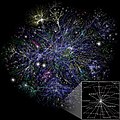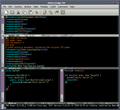Portal:Computer programming
Portal maintenance status: (September 2019)
|
The Computer Programming Portal
Computer programming or coding is the composition of sequences of instructions, called programs, that computers can follow to perform tasks. It involves designing and implementing algorithms, step-by-step specifications of procedures, by writing code in one or more programming languages. Programmers typically use high-level programming languages that are more easily intelligible to humans than machine code, which is directly executed by the central processing unit. Proficient programming usually requires expertise in several different subjects, including knowledge of the application domain, details of programming languages and generic code libraries, specialized algorithms, and formal logic.
Auxiliary tasks accompanying and related to programming include analyzing requirements, testing, debugging (investigating and fixing problems), implementation of build systems, and management of derived artifacts, such as programs' machine code. While these are sometimes considered programming, often the term software development is used for this larger overall process – with the terms programming, implementation, and coding reserved for the writing and editing of code per se. Sometimes software development is known as software engineering, especially when it employs formal methods or follows an engineering design process. (Full article...)
Selected articles - load new batch
-
Image 1

A 12-row/80-column IBM punched card from the mid-twentieth century
A punched card (also punch card or punched-card) is a stiff paper-based medium used to store digital information via the presence or absence of holes in predefined positions. Developed over the 18th to 20th centuries, punched cards were widely used for data processing, automation, and computing. Early applications included controlling weaving looms and recording census data. In the 20th century, they became central to business operations and early computers for input, output, and storage. IBM's 80-column format became a dominant standard, and punched cards were used for decades before being replaced by magnetic storage and terminals. Their influence persists in cultural references, standardized data layouts, and computing conventions such as 80-character line widths.
Punched cards were once common in data processing and the control of automated machines.
Punched cards were widely used in the 20th century, where unit record machines, organized into data processing systems, used punched cards for data input, data output, and data storage. The IBM 12-row/80-column punched card format came to dominate the industry. Many early digital computers used punched cards as the primary medium for input of both computer programs and data. (Full article...) -
Image 2
MATLAB (an abbreviation of "MATrix LABoratory") is a proprietary multi-paradigm programming language and numeric computing environment developed by MathWorks. MATLAB allows matrix manipulations, plotting of functions and data, implementation of algorithms, creation of user interfaces, and interfacing with programs written in other languages.
Although MATLAB is intended primarily for numeric computing, an optional toolbox uses the MuPAD symbolic engine allowing access to symbolic computing abilities. An additional package, Simulink, adds graphical multi-domain simulation and model-based design for dynamic and embedded systems.
As of 2020[update], MATLAB has more than four million users worldwide. They come from various backgrounds of engineering, science, and economics. As of 2017[update], more than 5000 global colleges and universities use MATLAB to support instruction and research. (Full article...) -
Image 3
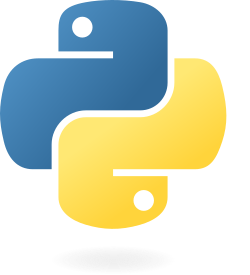
Python is a high-level, general-purpose programming language. Its design philosophy emphasizes code readability with the use of significant indentation.
Python is dynamically type-checked and garbage-collected. It supports multiple programming paradigms, including structured (particularly procedural), object-oriented and functional programming. It is often described as a "batteries included" language due to its comprehensive standard library.
Guido van Rossum began working on Python in the late 1980s as a successor to the ABC programming language, and he first released it in 1991 as Python 0.9.0. Python 2.0 was released in 2000. Python 3.0, released in 2008, was a major revision not completely backward-compatible with earlier versions. Python 2.7.18, released in 2020, was the last release of Python 2. (Full article...) -
Image 4
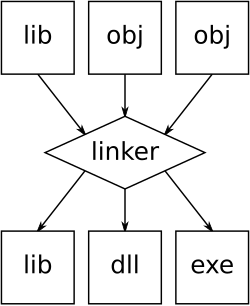
An illustration of the linking process. Object files and static libraries are assembled into a new library or executable
A linker or link editor is a computer program that combines intermediate software build files such as object and library files into a single executable file such as a program or library. A linker is often part of a toolchain that includes a compiler and/or assembler that generates intermediate files that the linker processes. The linker may be integrated with other toolchain tools such that the user does not interact with the linker directly.
A simpler version that writes its output directly to memory is called the loader, though loading is typically considered a separate process. (Full article...) -
Image 5Computer programming or coding is the composition of sequences of instructions, called programs, that computers can follow to perform tasks. It involves designing and implementing algorithms, step-by-step specifications of procedures, by writing code in one or more programming languages. Programmers typically use high-level programming languages that are more easily intelligible to humans than machine code, which is directly executed by the central processing unit. Proficient programming usually requires expertise in several different subjects, including knowledge of the application domain, details of programming languages and generic code libraries, specialized algorithms, and formal logic.
Auxiliary tasks accompanying and related to programming include analyzing requirements, testing, debugging (investigating and fixing problems), implementation of build systems, and management of derived artifacts, such as programs' machine code. While these are sometimes considered programming, often the term software development is used for this larger overall process – with the terms programming, implementation, and coding reserved for the writing and editing of code per se. Sometimes software development is known as software engineering, especially when it employs formal methods or follows an engineering design process. (Full article...) -
Image 6
Stephen Gary Wozniak (/ˈwɒzniæk/; born August 11, 1950), also known by his nickname Woz, is an American technology entrepreneur, electrical engineer, computer programmer, philanthropist, and inventor. In 1976, he co-founded Apple Computer with his early business partner Steve Jobs. Through his work at Apple in the 1970s and 1980s, he is widely recognized as one of the most prominent pioneers of the personal computer revolution.
In 1975, Wozniak started developing the Apple I into the computer that launched Apple when he and Jobs first began marketing it the following year. He was the primary designer of the Apple II, introduced in 1977, known as one of the first highly successful mass-produced microcomputers, while Jobs oversaw the development of its foam-molded plastic case and early Apple employee Rod Holt developed its switching power supply.
With human–computer interface expert Jef Raskin, Wozniak had a major influence over the initial development of the original Macintosh concepts from 1979 to 1981, when Jobs took over the project following Wozniak's brief departure from the company due to a traumatic airplane accident. After permanently leaving Apple in 1985, Wozniak founded CL 9 and created the first programmable universal remote, released in 1987. He then pursued several other businesses and philanthropic ventures throughout his career, focusing largely on technology in K–12 schools. (Full article...) -
Image 7
Augusta Ada King, Countess of Lovelace (née Byron; 10 December 1815 – 27 November 1852), also known as Ada Lovelace, was an English mathematician and writer chiefly known for her work on Charles Babbage's proposed mechanical general-purpose computer, the Analytical Engine. She was the first to recognise that the machine had applications beyond pure calculation.
Lovelace was the only legitimate child of poet Lord Byron and reformer Anne Isabella Milbanke. All her half-siblings, Lord Byron's other children, were born out of wedlock to other women. Lord Byron separated from his wife a month after Ada was born and left England forever. He died in Greece when she was eight. Lady Byron was anxious about her daughter's upbringing and promoted Lovelace's interest in mathematics and logic in an effort to prevent her from developing her father's perceived insanity. Despite this, Lovelace remained interested in her father, naming her two sons Byron and Gordon. Upon her death, she was buried next to her father at her request. Although often ill in her childhood, Lovelace pursued her studies assiduously. She married William King in 1835. King was made Earl of Lovelace in 1838, Ada thereby becoming Countess of Lovelace.
Lovelace's educational and social exploits brought her into contact with scientists such as Andrew Crosse, Charles Babbage, Sir David Brewster, Charles Wheatstone and Michael Faraday, and the author Charles Dickens, contacts which she used to further her education. Lovelace described her approach as "poetical science" and herself as an "Analyst (& Metaphysician)". (Full article...) -
Image 8

Tcl (pronounced "tickle" or "TCL"; originally Tool Command Language) is a high-level, general-purpose, interpreted, dynamic programming language. It was designed with the goal of being very simple but powerful. Tcl casts everything into the mold of a command, even programming constructs like variable assignment and procedure definition. Tcl supports multiple programming paradigms, including object-oriented, imperative, functional, and procedural styles.
It is commonly used embedded into C applications, for rapid prototyping, scripted applications, GUIs, and testing. Tcl interpreters are available for many operating systems, allowing Tcl code to run on a wide variety of systems. Because Tcl is a very compact language, it is used on embedded systems platforms, both in its full form and in several other small-footprint versions.
The popular combination of Tcl with the Tk extension is referred to as Tcl/Tk (pronounced "tickle teak"[citation needed] or "tickle TK") and enables building a graphical user interface (GUI) natively in Tcl. Tcl/Tk is included in the standard Python installation in the form of Tkinter. (Full article...) -
Image 9
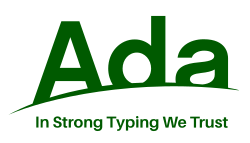
Ada is a structured, statically typed, imperative, and object-oriented high-level programming language, inspired by Pascal and other languages. It has built-in language support for design by contract (DbC), extremely strong typing, explicit concurrency, tasks, synchronous message passing, protected objects, and non-determinism. Ada improves code safety and maintainability by using the compiler to find errors in favor of runtime errors. Ada is an international technical standard, jointly defined by the International Organization for Standardization (ISO), and the International Electrotechnical Commission (IEC). As of May 2023[update], the standard, ISO/IEC 8652:2023, is called Ada 2022 informally.
Ada was originally designed by a team led by French computer scientist Jean Ichbiah of Honeywell under contract to the United States Department of Defense (DoD) from 1977 to 1983 to supersede over 450 programming languages then used by the DoD. Ada was named after Ada Lovelace (1815–1852), who has been credited as the first computer programmer. (Full article...) -
Image 10In computing, a compiler is a computer program that translates computer code written in one programming language (the source language) into another language (the target language). The name "compiler" is primarily used for programs that translate source code from a high-level programming language to a low-level programming language (e.g. assembly language, object code, or machine code) to create an executable program.
There are many different types of compilers which produce output in different useful forms. A cross-compiler produces code for a different CPU or operating system than the one on which the cross-compiler itself runs. A bootstrap compiler is often a temporary compiler, used for compiling a more permanent or better optimised compiler for a language.
Related software include decompilers, programs that translate from low-level languages to higher level ones; programs that translate between high-level languages, usually called source-to-source compilers or transpilers; language rewriters, usually programs that translate the form of expressions without a change of language; and compiler-compilers, compilers that produce compilers (or parts of them), often in a generic and reusable way so as to be able to produce many differing compilers. (Full article...) -
Image 11
Charles Babbage KH FRS (/ˈbæbɪdʒ/; 26 December 1791 – 18 October 1871) was an English polymath. A mathematician, philosopher, inventor and mechanical engineer, Babbage originated the concept of a digital programmable computer.
Babbage is considered by some to be "father of the computer". He is credited with inventing the first mechanical computer, the difference engine, that eventually led to more complex electronic designs, though all the essential ideas of modern computers are to be found in his analytical engine, programmed using a principle openly borrowed from the Jacquard loom. As part of his computer work, he also designed the first computer printers. He had a broad range of interests in addition to his work on computers covered in his 1832 book Economy of Manufactures and Machinery. He was an important figure in the social scene in London, and is credited with importing the "scientific soirée" from France with his well-attended Saturday evening soirées. His varied work in other fields has led him to be described as "pre-eminent" among the many polymaths of his century.
Babbage, who died before the complete successful engineering of many of his designs, including his Difference Engine and Analytical Engine, remained a prominent figure in the ideating of computing. Parts of his incomplete mechanisms are on display in the Science Museum in London. In 1991, a functioning difference engine was constructed from the original plans. Built to tolerances achievable in the 19th century, the success of the finished engine indicated that Babbage's machine would have worked. (Full article...) -
Image 12Atari BASIC (1979) for Atari 8-bit computers
BASIC (Beginners' All-purpose Symbolic Instruction Code) is a family of general-purpose, high-level programming languages designed for ease of use. The original version was created by John G. Kemeny and Thomas E. Kurtz at Dartmouth College in 1963. They wanted to enable students in non-scientific fields to use computers. At the time, nearly all computers required writing custom software, which only scientists and mathematicians tended to learn.
In addition to the programming language, Kemeny and Kurtz developed the Dartmouth Time-Sharing System (DTSS), which allowed multiple users to edit and run BASIC programs simultaneously on remote terminals. This general model became popular on minicomputer systems like the PDP-11 and Data General Nova in the late 1960s and early 1970s. Hewlett-Packard produced an entire computer line for this method of operation, introducing the HP2000 series in the late 1960s and continuing sales into the 1980s. Many early video games trace their history to one of these versions of BASIC.
The emergence of microcomputers in the mid-1970s led to the development of multiple BASIC dialects, including Microsoft BASIC in 1975. Due to the tiny main memory available on these machines, often 4 KB, a variety of Tiny BASIC dialects were also created. BASIC was available for almost any system of the era and became the de facto programming language for home computer systems that emerged in the late 1970s. These PCs almost always had a BASIC interpreter installed by default, often in the machine's firmware or sometimes on a ROM cartridge. (Full article...) -
Image 13Programming languages are used for controlling the behavior of a machine (often a computer). Like natural languages, programming languages follow rules for syntax and semantics.
There are thousands of programming languages and new ones are created every year. Few languages ever become sufficiently popular that they are used by more than a few people, but professional programmers may use dozens of languages in a career.
Most programming languages are not standardized by an international (or national) standard, even widely used ones, such as Perl or Standard ML (despite the name). Notable standardized programming languages include ALGOL, C, C++, JavaScript (under the name ECMAScript), Smalltalk, Prolog, Common Lisp, Scheme (IEEE standard), ISLISP, Ada, Fortran, COBOL, SQL, and XQuery. (Full article...) -
Image 14
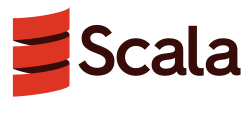
Scala (/ˈskɑːlɑː/ SKAH-lah) is a strong statically typed high-level general-purpose programming language that supports both object-oriented programming and functional programming. Designed to be concise, many of Scala's design decisions are intended to address criticisms of Java.
Scala source code can be compiled to Java bytecode and run on a Java virtual machine (JVM). Scala can also be transpiled to JavaScript to run in a browser, or compiled directly to a native executable. When running on the JVM, Scala provides language interoperability with Java so that libraries written in either language may be referenced directly in Scala or Java code. Like Java, Scala is object-oriented, and uses a syntax termed curly-brace which is similar to the language C. Since Scala 3, there is also an option to use the off-side rule (indenting) to structure blocks, and its use is advised. Martin Odersky has said that this turned out to be the most productive change introduced in Scala 3.
Unlike Java, Scala has many features of functional programming languages (like Scheme, Standard ML, and Haskell), including currying, immutability, lazy evaluation, and pattern matching. It also has an advanced type system supporting algebraic data types, covariance and contravariance, higher-order types (but not higher-rank types), anonymous types, operator overloading, optional parameters, named parameters, raw strings, and an experimental exception-only version of algebraic effects that can be seen as a more powerful version of Java's checked exceptions. (Full article...) -
Image 15

Erlang (/ˈɜːrlæŋ/ UR-lang) is a general-purpose, concurrent, functional high-level programming language, and a garbage-collected runtime system. The term Erlang is used interchangeably with Erlang/OTP, or Open Telecom Platform (OTP), which consists of the Erlang runtime system, several ready-to-use components (OTP) mainly written in Erlang, and a set of design principles for Erlang programs.
The Erlang runtime system is designed for systems with these traits:- Distributed
- Fault-tolerant
- Soft real-time
- Highly available, non-stop applications
- Hot swapping, where code can be changed without stopping a system.
Selected images
-
Image 1Stephen Wolfram is a British-American computer scientist, physicist, and businessman. He is known for his work in computer science, mathematics, and in theoretical physics.
-
Image 3Partial map of the Internet based on the January 15, 2005 data found on opte.org. Each line is drawn between two nodes, representing two IP addresses. The length of the lines are indicative of the delay between those two nodes. This graph represents less than 30% of the Class C networks reachable by the data collection program in early 2005.
-
Image 4A head crash on a modern hard disk drive
-
Image 5A view of the GNU nano Text editor version 6.0
-
Image 7Deep Blue was a chess-playing expert system run on a unique purpose-built IBM supercomputer. It was the first computer to win a game, and the first to win a match, against a reigning world champion under regular time controls. Photo taken at the Computer History Museum.
-
Image 8GNOME Shell, GNOME Clocks, Evince, gThumb and GNOME Files at version 3.30, in a dark theme
-
Image 9An IBM Port-A-Punch punched card
-
Image 10A lone house. An image made using Blender 3D.
-
Image 11Partial view of the Mandelbrot set. Step 1 of a zoom sequence: Gap between the "head" and the "body" also called the "seahorse valley".
-
Image 12Grace Hopper at the UNIVAC keyboard, c. 1960. Grace Brewster Murray: American mathematician and rear admiral in the U.S. Navy who was a pioneer in developing computer technology, helping to devise UNIVAC I. the first commercial electronic computer, and naval applications for COBOL (common-business-oriented language).
-
Image 13This image (when viewed in full size, 1000 pixels wide) contains 1 million pixels, each of a different color.
-
Image 15Ada Lovelace was an English mathematician and writer, chiefly known for her work on Charles Babbage's proposed mechanical general-purpose computer, the Analytical Engine. She was the first to recognize that the machine had applications beyond pure calculation, and to have published the first algorithm intended to be carried out by such a machine. As a result, she is often regarded as the first computer programmer.
-
Image 16Margaret Hamilton standing next to the navigation software that she and her MIT team produced for the Apollo Project.
-
Image 18Output from a (linearised) shallow water equation model of water in a bathtub. The water experiences 5 splashes which generate surface gravity waves that propagate away from the splash locations and reflect off of the bathtub walls.
Did you know? - load more entries

- ... that Rust has been named the "most loved programming language" every year for seven years since 2016 by annual surveys conducted by Stack Overflow?
- ... that Phil Fletcher as Hacker T. Dog caused Lauren Layfield to make the "most famous snort" in the United Kingdom in 2016?
- ... that the 2024 psychological horror game Mouthwashing utilises non-diegetic scene transitions that mimic glitches and crashes?
- ... that a "hacker" with blog posts written by ChatGPT was at the center of an online scavenger hunt promoting Avenged Sevenfold's album Life Is but a Dream...?
- ... that a pink skin for Mercy in the video game Overwatch helped raise more than $12 million for breast cancer research?
- ... that NATO was once targeted by a group of "gay furry hackers"?
Subcategories
WikiProjects
- There are many users interested in computer programming, join them.
Computer programming news
No recent news
Topics
Related portals
Associated Wikimedia
The following Wikimedia Foundation sister projects provide more on this subject:
-
Commons
Free media repository -
Wikibooks
Free textbooks and manuals -
Wikidata
Free knowledge base -
Wikinews
Free-content news -
Wikiquote
Collection of quotations -
Wikisource
Free-content library -
Wikiversity
Free learning tools -
Wiktionary
Dictionary and thesaurus

















